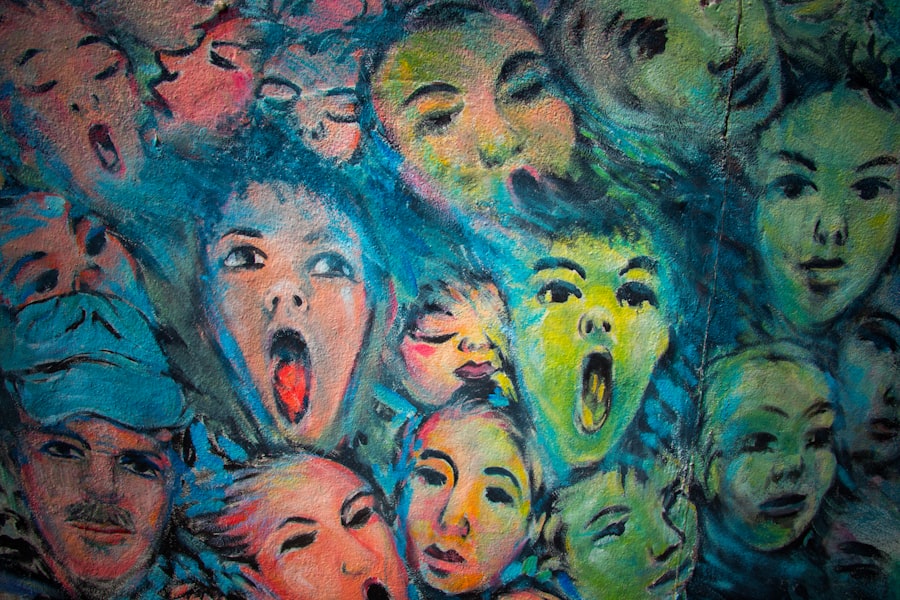Panic disorder is a mental health condition characterized by recurrent and unexpected panic attacks. These attacks are sudden surges of intense fear or discomfort that peak within minutes, often accompanied by a range of physical and emotional symptoms. You may find yourself experiencing a racing heart, shortness of breath, or an overwhelming sense of impending doom.
The unpredictability of these attacks can lead to significant anxiety about when the next one might occur, which can severely impact your daily life. Living with panic disorder can feel isolating, as you may struggle to understand why these episodes happen. The fear of having another attack can lead you to avoid certain situations or places where you previously experienced panic, further limiting your activities and social interactions.
This avoidance behavior can create a cycle of anxiety that reinforces the disorder, making it essential to recognize and address the symptoms and triggers associated with panic disorder.
Key Takeaways
- Panic disorder is a type of anxiety disorder characterized by sudden and repeated attacks of fear and anxiety.
- Symptoms of panic disorder include sudden and intense feelings of fear, heart palpitations, sweating, trembling, and a sense of impending doom.
- Depersonalization is a mental health condition where a person feels detached from themselves, as if they are observing their own body from the outside.
- Derealization is a mental health condition where a person feels detached from their surroundings, as if the world around them is unreal or distorted.
- Depersonalization and derealization are often experienced alongside panic disorder, and can have a significant impact on daily life, including relationships and work.
Symptoms of Panic Disorder
The symptoms of panic disorder can vary widely from person to person, but they often include both physical and psychological manifestations. You might experience heart palpitations, sweating, trembling, or feelings of choking during an attack. These physical symptoms can be so intense that they mimic those of a heart attack, leading many individuals to seek emergency medical attention.
Alongside these physical sensations, you may also grapple with feelings of unreality or detachment from yourself, which can be particularly distressing. In addition to the immediate symptoms experienced during a panic attack, you may also face ongoing anxiety about future attacks. This anticipatory anxiety can lead to a constant state of heightened alertness, making it difficult for you to relax or enjoy everyday activities.
You might find yourself preoccupied with thoughts about your health or fearing that you will lose control in public settings. Understanding these symptoms is crucial for recognizing panic disorder and seeking appropriate help.
Understanding Depersonalization

Depersonalization is a dissociative symptom that can occur in various mental health conditions, including panic disorder. When you experience depersonalization, you may feel detached from your own thoughts, feelings, or sense of self. It’s as if you are observing yourself from outside your body, leading to a sense of unreality that can be disconcerting.
You might describe this feeling as being in a dreamlike state or feeling like you are watching your life unfold from a distance. This sensation can be triggered by extreme stress or anxiety, often surfacing during or after a panic attack. You may find it challenging to connect with your emotions or even recognize your own identity during these episodes.
This disconnection can exacerbate feelings of fear and confusion, making it difficult for you to navigate daily life. Understanding depersonalization is essential for recognizing its role in your experiences with panic disorder.
Understanding Derealization
| Metrics | Statistics |
|---|---|
| Prevalence of Derealization | 1-2% of the population |
| Age of Onset | Usually in adolescence or early adulthood |
| Duration of Episodes | Can last from a few minutes to several years |
| Associated Conditions | Anxiety disorders, depression, PTSD |
| Treatment Options | Therapy, medication, mindfulness techniques |
Derealization is another dissociative experience that often accompanies depersonalization. When you experience derealization, the world around you may seem distorted or unreal. You might perceive your surroundings as foggy or dreamlike, leading to a sense of detachment from reality.
This can be particularly alarming, as it may feel like you are living in a movie or that the people and objects around you are not quite real. Like depersonalization, derealization can be triggered by high levels of stress or anxiety. During a panic attack, you may suddenly feel as though the environment is shifting or that time is moving differently.
This sensation can heighten your sense of fear and contribute to the overall distress associated with panic disorder. Recognizing derealization as a symptom is crucial for understanding how it intertwines with your experiences of panic.
How Depersonalization and Derealization Relate to Panic Disorder
The relationship between depersonalization, derealization, and panic disorder is complex yet significant. Both depersonalization and derealization can serve as coping mechanisms in response to overwhelming anxiety. When faced with the intense fear of a panic attack, your mind may resort to these dissociative experiences as a way to protect itself from emotional pain.
This means that while they may provide temporary relief from anxiety, they can also create additional layers of distress. You might find that experiencing depersonalization or derealization during a panic attack intensifies your fear and confusion. Instead of feeling grounded in reality, you may feel even more disconnected from yourself and your surroundings.
This cycle can perpetuate the panic disorder, as the fear of losing touch with reality can lead to increased avoidance behaviors and heightened anxiety about future attacks. Understanding this relationship is vital for developing effective coping strategies.
The Impact of Depersonalization and Derealization on Daily Life

The impact of depersonalization and derealization on your daily life can be profound. These experiences can interfere with your ability to engage fully in relationships, work, and leisure activities. You may find it challenging to concentrate on tasks or connect with others emotionally when you feel detached from yourself or your surroundings.
This disconnection can lead to feelings of loneliness and frustration, as you struggle to communicate your experiences to those around you. Moreover, the unpredictability of these dissociative symptoms can create a sense of instability in your life. You might avoid situations where you fear experiencing depersonalization or derealization, leading to social withdrawal and isolation.
This avoidance can further exacerbate feelings of anxiety and depression, creating a cycle that feels difficult to break. Recognizing the impact of these symptoms on your daily life is an essential step toward seeking help and finding effective coping strategies.
Triggers for Depersonalization and Derealization in Panic Disorder
Identifying triggers for depersonalization and derealization within the context of panic disorder is crucial for managing these experiences effectively. Common triggers may include high-stress situations, overwhelming emotions, or even specific environments that remind you of past panic attacks. You might notice that certain social settings or crowded places heighten your anxiety levels, leading to an increased likelihood of experiencing dissociative symptoms.
Additionally, fatigue and lack of sleep can also serve as triggers for depersonalization and derealization. When you are physically exhausted or mentally drained, your ability to cope with stress diminishes, making it easier for these symptoms to surface. By recognizing your personal triggers, you can develop strategies to manage them more effectively and reduce the frequency and intensity of dissociative experiences.
Coping Strategies for Depersonalization and Derealization
Implementing coping strategies for managing depersonalization and derealization can significantly improve your quality of life. Grounding techniques are particularly effective in helping you reconnect with reality during episodes of dissociation. These techniques may include focusing on your breath, engaging your senses by touching objects around you, or practicing mindfulness exercises that encourage present-moment awareness.
Another helpful strategy is to establish a routine that incorporates self-care practices such as regular exercise, healthy eating, and sufficient sleep. These lifestyle choices can enhance your overall well-being and resilience against stressors that trigger panic attacks and dissociative symptoms. Additionally, journaling about your experiences can provide insight into patterns and triggers while serving as an emotional outlet.
Seeking Help for Depersonalization and Derealization in Panic Disorder
If you find yourself struggling with depersonalization and derealization alongside panic disorder, seeking professional help is essential. A mental health professional can provide support tailored to your specific needs and experiences. Therapy options such as cognitive-behavioral therapy (CBT) have proven effective in addressing both panic disorder and dissociative symptoms by helping you reframe negative thought patterns and develop healthier coping mechanisms.
You might also consider joining support groups where individuals share similar experiences with panic disorder and dissociation. Connecting with others who understand what you’re going through can provide validation and encouragement as you navigate your journey toward healing.
Treatment Options for Depersonalization and Derealization
Treatment options for depersonalization and derealization often involve a combination of therapy and medication. Cognitive-behavioral therapy (CBT) remains one of the most effective therapeutic approaches for addressing panic disorder and its associated symptoms. Through CBT, you will learn techniques to challenge irrational thoughts and beliefs while developing healthier coping strategies.
In some cases, medication may also be prescribed to help manage anxiety levels associated with panic disorder. Antidepressants or anti-anxiety medications can help stabilize mood and reduce the frequency of panic attacks, which may subsequently lessen the occurrence of dissociative symptoms like depersonalization and derealization.
Managing Panic Disorder with Depersonalization and Derealization
Managing panic disorder while dealing with depersonalization and derealization requires a multifaceted approach that combines self-awareness, coping strategies, professional support, and treatment options. By understanding how these experiences interconnect, you can develop a more comprehensive plan for managing your mental health. As you work through this journey, remember that progress takes time and patience.
Celebrate small victories along the way while remaining open to learning more about yourself and your triggers. With the right tools and support system in place, you can navigate the challenges posed by panic disorder alongside depersonalization and derealization while reclaiming control over your life.
Panic disorder often intertwines with experiences of depersonalization and derealization, creating a complex web of symptoms that can be challenging to navigate. These dissociative symptoms can make individuals feel disconnected from themselves or their surroundings, exacerbating the anxiety and fear associated with panic attacks. For a deeper understanding of how these conditions interrelate and impact mental health, you can explore an insightful article on the topic by visiting Unplugged Psych. This resource provides valuable information and strategies for managing these symptoms effectively.
LEARN MORE About Unmasking the Mysteries Behind Depersonalization and Derealization
FAQs
What is panic disorder?
Panic disorder is a type of anxiety disorder characterized by recurrent and unexpected panic attacks. These attacks are accompanied by intense fear and physical symptoms such as rapid heart rate, sweating, trembling, and shortness of breath.
What is depersonalization?
Depersonalization is a mental health condition in which a person feels detached from their own thoughts, feelings, and sensations. They may feel as though they are observing themselves from outside their body or that their body and mind are not connected.
What is derealization?
Derealization is a mental health condition in which a person feels detached from their surroundings. They may perceive the world as unreal, dreamlike, or distorted, and may feel disconnected from the environment and the people around them.
What are the symptoms of panic disorder with depersonalization and derealization?
Symptoms of panic disorder with depersonalization and derealization may include recurrent panic attacks, feelings of detachment from oneself or the environment, intense fear, physical symptoms such as rapid heart rate and sweating, and a sense of unreality.
What causes panic disorder with depersonalization and derealization?
The exact cause of panic disorder with depersonalization and derealization is not fully understood, but it is believed to involve a combination of genetic, biological, and environmental factors. Trauma, stress, and a history of anxiety may also contribute to the development of these conditions.
How is panic disorder with depersonalization and derealization treated?
Treatment for panic disorder with depersonalization and derealization may include a combination of medication, such as antidepressants or anti-anxiety drugs, and psychotherapy, such as cognitive-behavioral therapy (CBT). Lifestyle changes, stress management techniques, and relaxation exercises may also be helpful in managing symptoms.




